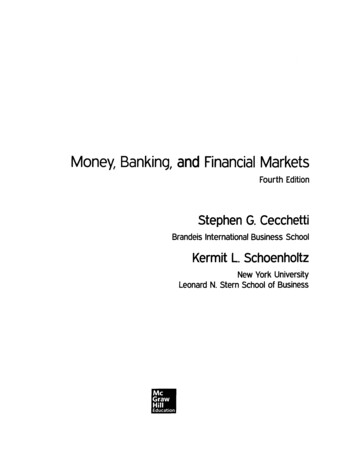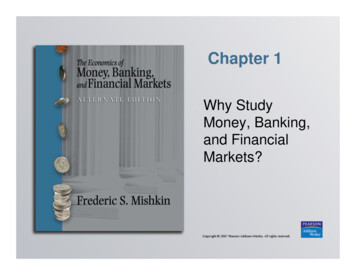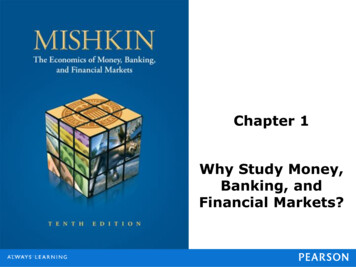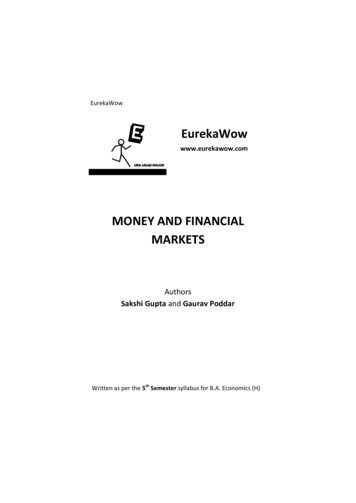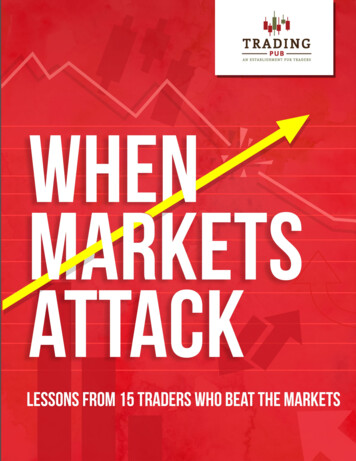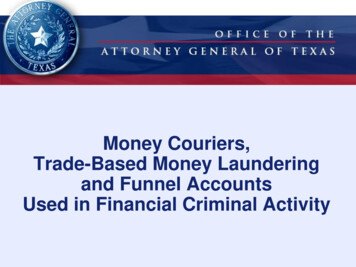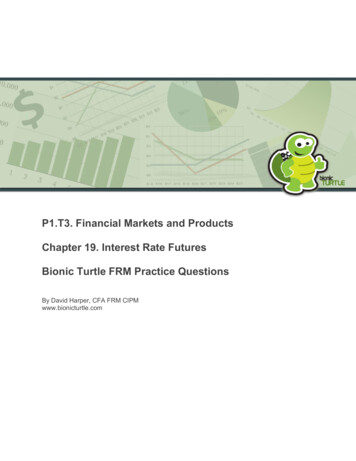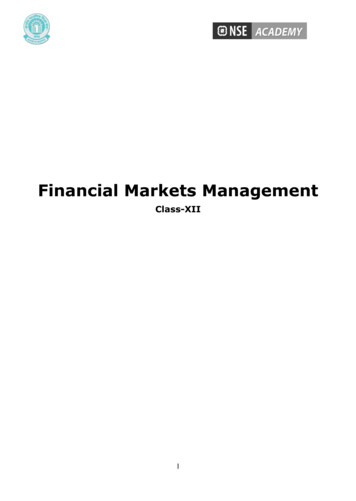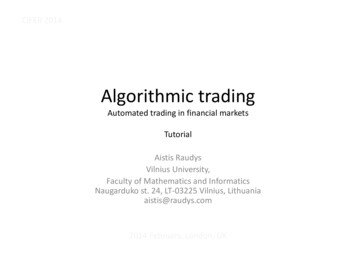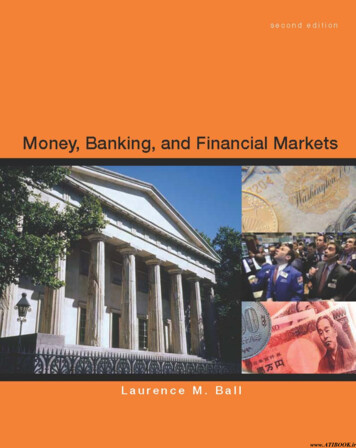
Transcription
www.ATIBOOK.ir
This page was intentionally left blankwww.ATIBOOK.ir
Money, Banking, and Financial Marketswww.ATIBOOK.ir
The building on this book’s cover is the Second Bank of the United States, located inPhiladelphia. It operated from 1816 to 1836, serving some of the functions of the modernFederal Reserve. President Andrew Jackson vetoed legislation to extend the Bank’s charterbecause he believed it served “moneyed interests” at the expense of common people (seeChapter 8).To the right of the Second Bank, the central photo shows a specialist (in a blue coat) andtraders at work on the floor of the New York Stock Exchange (see Chapter 5). They areflanked by two currencies. At the top is a gold certificate, a type of money used in the UnitedStates in the late nineteenth and early twentieth centuries (see Chapter 2); at the bottom areJapanese yen.www.ATIBOOK.ir
SECOND EDITIONMoney, Banking, and Financial MarketsLaurence M. BallJohns Hopkins UniversityWORTH PUBLISHERSwww.ATIBOOK.ir
Senior Publisher: Catherine WoodsExecutive Editor: Charles LinsmeierSenior Acquisitions Editor: Sarah DorgerExecutive Marketing Manager: Scott GuileSenior Development Editor: Marie McHaleDevelopment Editor: Barbara BrooksAssociate Media Editor: Jaclyn CastaldoEditorial Assistant: Mary WalshAssociate Managing Editor: Tracey KuehnProject Editor: Kerry O’ShaughnessyPhoto Editor: Cecilia VarasPhoto Researcher: Julie TesserArt Director: Babs ReingoldSenior Designer, Cover Designer: Kevin KallProduction Manager: Barbara Anne SeixasComposition: MPS Limited, a Macmillan CompanyPrinting and Binding: Quad Graphics, VersaillesCover Photos: Second Bank of the United States PHILADELPHIA USA: Aflo Co. Ltd./Alamy; Stock brokers: AP Photo/Richard Drew; Gold certificate and gold coins: Corbis Premium RF/AlamyLibrary of Congress Control Number: 2011920626ISBN-13: 978-1-4292-4409-1ISBN-10: 1-4292-4409-7 2009, 2012 by Worth PublishersAll rights reservedPrinted in the United States of AmericaFirst printing 2011Worth Publishers41 Madison AvenueNew York, NY www.ATIBOOK.ir
Laurence Ballis Professor of Economics at Johns HopkinsUniversity. He holds a Ph.D. in economics from the MassachusettsInstitute of Technology and a B.A. in economics from AmherstCollege. Professor Ball is a Research Associate of the NationalBureau of Economic Research and has been a visiting scholar at theFederal Reserve, the Bank of Japan, the Central Bank of Norway,the Reserve Bank of Australia, and the Hong Kong MonetaryAuthority. His academic honors include the Houblon-NormanFellowship (Bank of England), a Professorial Fellowship in MonetaryEconomics (Victoria University of Wellington and Reserve Bank ofNew Zealand), the NBER Olin Fellowship, and the Alfred P. SloanResearch Fellowship. He is the coauthor with N. Gregory Mankiw ofMacroeconomics and the Financial System (Worth Publishers).Professor Ball lives in Baltimore with his wife, Patricia, and their son,Leverett.www.ATIBOOK.ir
To Patriciawww.ATIBOOK.ir
CONTENTS viibrief contentsPreface xxvSupplements and Media xxxiiiPART I FOUNDATIONS1 The Financial System 12 Money and Central Banks 25PART II FINANCIAL MARKETS3 Asset Prices and Interest Rates 534 What Determines Interest Rates? 855 Securities Markets 1216 Foreign Exchange Markets 157PART III BANKING7 Asymmetric Information in the FinancialSystem 1898 The Banking Industry 2219 The Business of Banking 25310 Bank Regulation 285PART IV MONEY AND THE ECONOMY11 The Money Supply and Interest Rates 31512 Short-Run Economic Fluctuations 34713 Economic Fluctuations, Monetary Policy,and the Financial System 38914 Inflation and Deflation 419PART V MONETARY POLICY15 Policies for Economic Stability 45116 Monetary Institutions and Strategies 48317 Monetary Policy and Exchange Rates 51918 Financial Crises 551Glossary G-1Index I-1 viiwww.ATIBOOK.ir
This page intentionally left blankwww.ATIBOOK.ir
CONTENTS ixcontentsPreface xxvSupplements and Media xxxiiiindicates coverage of financial crises.PART I FOUNDATIONSChapter 1 The Financial System 11.1 Financial Markets 2Bonds 2Stocks 31.2 Economic Functions of Financial Markets 4Matching Savers and Investors 4Risk Sharing 5CASE STUDY: The Perils of Employee Stock Ownership 61.3 Asymmetric Information 7Adverse Selection 8Moral Hazard 91.4 Banks 10What Is a Bank? 10Banks Versus Financial Markets 11Why Banks Exist 121.5 The Financial System and Economic Growth 13Saving and Economic Growth 13The Allocation of Saving 14Evidence on the Financial System and Growth 14CASE STUDY: Unit Banking and Economic Growth 16CASE STUDY: Microfinance 17Markets Versus Central Planning 19Online Case StudyAn Update on MicrofinanceCASE STUDY: Investment in the Soviet Union 191.6 Financial Crises 21Summary 21Key Terms 22Questions and Problems 23Appendix: Measuring Output and the Price Level 24 ixwww.ATIBOOK.ir
x CONTENTSChapter 2 Money and Central Banks 252.1 What Is Money? 26The Medium of Exchange 26Money Versus Barter 27CASE STUDY: Nineteenth-Century Visitors to Barter Economies 28The Unit of Account 28A Store of Value 292.2 Types of Money 29Commodity Money 30Fiat Money 31From Commodity Money to Fiat Money 32CASE STUDY: The History of the U.S. Dollar 32Online Case StudyAlternative Currenciesin the United StatesAlternatives to a National Currency 34CASE STUDY: Clean and Dirty Money 362.3 Money Today 37Measuring the Money Supply: M1 37How We Spend Money 37What About Credit Cards? 39The Payments System 39New Kinds of Money 412.4 Liquidity and Broad Money 42The Need for Liquidity 42Degrees of Liquidity 43Measuring Broad Money: M2 44CASE STUDY: Sweep Programs 452.5 Functions of Central Banks 47Clearing Payments 47Monetary Policy 47Emergency Lending 47Financial Regulation 47CASE STUDY: The Fed and September 11 482.6 The Rest of This Book 49Financial Markets 49Banking 49Money and the Economy 50Monetary Policy 50Summary 50Key Terms 51Questions and Problems 52www.ATIBOOK.ir
CONTENTS xiPART II FINANCIAL MARKETSChapter 3 Asset Prices and Interest Rates 533.1 Valuing Income Streams 54Future Value 54Present Value 543.2 The Classical Theory of Asset Prices 57The Present Value of Income 57What Determines Expectations? 59What Is the Relevant Interest Rate? 59The Gordon Growth Model of Stock Prices 603.3 Fluctuations in Asset Prices 61Why Do Asset Prices Change? 61CASE STUDY: The Fed and the Stock Market 62Which Asset Prices Are Most Volatile? 633.4 Asset-Price Bubbles 64How Bubbles Work 65CASE STUDY: Tulipmania 66Looking for Bubbles 66CASE STUDY: The U.S. Stock Market, 1990–2010 683.5 Asset-Price Crashes 70Online Case StudyAn Update on theStock MarketHow Crashes Work 71CASE STUDY: The Two Big Crashes 71Crash Prevention 733.6 Measuring Interest Rates and Asset Returns 73Yield to Maturity 74The Rate of Return 75Returns on Stocks and Bonds 76Rate of Return Versus Yield to Maturity 763.7 Real and Nominal Interest Rates 77Real Interest Rates: Ex Ante Versus Ex Post 78CASE STUDY: Inflation and the Savings and Loan Crisis 79Inflation-Indexed Bonds 80Summary 81Key Terms 82Questions and Problems 82www.ATIBOOK.ir
xii C O N T E N T SChapter 4 What Determines Interest Rates? 854.1 The Loanable Funds Theory 86Saving, Investment, and Capital Flows 87Effects of the Real Interest Rate 88The Equilibrium Real Interest Rate 894.2 Determinants of Interest Rates in the Loanable Funds Theory 91Shifts in Investment 91Shifts in Saving 93CASE STUDY: Budget Deficits and Interest Rates 95Shifts in Capital Flows 96Nominal Interest Rates 974.3 The Liquidity Preference Theory 99The Market for Money 100The Equilibrium Interest Rate 100Changes in Interest Rates 101Relating the Two Theories of Interest Rates 1044.4 The Term Structure of Interest Rates 104The Term Structure Under Certainty 104The Expectations Theory of the Term Structure 106Accounting for Risk 107The Yield Curve 108CASE STUDY: Some Historical Examples of Yield Curves 1104.5 Default Risk and Interest Rates 111Default Risk on Sovereign Debt 112Online Case StudyAn Update onEuropean DebtCASE STUDY: Greece’s Debt Crisis 113Default Risk on Corporate Debt 114CASE STUDY: The High-Yield Spread 1154.6 Two Other Factors 117Liquidity 117Taxes 117Summary 118Key Terms 119Questions and Problems 119Chapter 5 Securities Markets 1215.1 Participants in Securities Markets 122Individual Owners 122Securities Firms 123Other Financial Institutions 124Financial Industry Consolidation 125www.ATIBOOK.ir
CONTENTSCASE STUDY: The Upheaval in Investment Banking 1255.2 Stock and Bond Markets 127 xiiiOnline Case StudyAn Update onInvestment BanksPrimary Markets 127CASE STUDY: Treasury Bill Auctions 129Secondary Markets 130Finding Information on Security Prices 1325.3 Capital Structure: What Securities Should Firms Issue? 133Is Capital Structure Irrelevant? 134Why Capital Structure Does Matter 134Debt Maturity 1355.4 Asset Allocation: What Assets Should Savers Hold? 136The Risk–Return Trade-Off 136Choosing the Mix 138CASE STUDY: Age and Asset Allocation 1405.5 Which Stocks? 140The Efficient Markets Hypothesis 140Choosing Between Two Kinds of Mutual Funds 142Can Anyone Beat the Market? 143CASE STUDY: The Oracle of Omaha 1455.6 Derivatives 146Futures 147Options 148Credit Default Swaps 148Hedging with Derivatives 149Speculating with Derivatives 150CASE STUDY: Credit Default Swaps and the AIG Fiasco 152Summary 153Key Terms 154Questions and Problems 154Chapter 6 Foreign Exchange Markets 1576.1 Currency Markets and Exchange Rates 158The Trading Process 158Measuring Exchange Rates 1606.2 Why Exchange Rates Matter 161Effects of Appreciation 161CASE STUDY: The Politics of the Dollar 163Hedging Exchange Rate Risk 164Real Versus Nominal Exchange Rates 165The Trade-Weighted Real Exchange Rate 167CASE STUDY: Exchange Rates and Steel 168www.ATIBOOK.ir
xiv C O N T E N T S6.3 The Long-Run Behavior of Exchange Rates 169Purchasing Power Parity 170How Reasonable Is PPP? 171Evidence for PPP 1716.4 Real Exchange Rates in the Short Run 173Net Exports and Capital Flows 173Effects of the Real Exchange Rate 174The Equilibrium Exchange Rate 1746.5 Fluctuations in Exchange Rates 175Shifts in Net Capital Outflows 175Online Case StudyAn Update onExchange RatesCASE STUDY: The Euro Versus the Dollar 177Shifts in Net Exports 179Nominal Rates Again 1806.6 Currency Speculation 182Forecasting Methods 182CASE STUDY: More on Technical Analysis 184Summary 185Key Terms 186Questions and Problems 186PART III BANKINGChapter 7 Asymmetric Information in theFinancial System 1897.1 Adverse Selection 190The Lemons Problem 190Lemons in Securities Markets 191Adverse Selection: A Numerical Example 1937.2 Moral Hazard 195Moral Hazard in Stock Markets 196Moral Hazard in Bond Markets 197The Numerical Example Again for Moral Hazard 197CASE STUDY: Ponzi Schemes 1987.3 Reducing Information Asymmetries 200Information Gathering 200The Free-Rider Problem 200Information-Gathering Firms 201CASE STUDY: Rating Agencies and Subprime Mortgages 201Online Case StudyAn Update onShareholder RightsBoards of Directors 202CASE STUDY: International Differences in Shareholder Rights 204Private Equity Firms 206www.ATIBOOK.ir
CONTENTS xv7.4 Regulation of Financial Markets 207Information Disclosure 208Insider Trading 209CASE STUDY: Some Inside Traders 2097.5 Banks and Asymmetric Information 210Information Gathering: Screening Borrowers 211Reducing Default Risk: Collateral and Net Worth 211Covenants and Monitoring 212Interest Rates and Credit Rationing 213CASE STUDY: The Five Cs of Business Lending 213CASE STUDY: Traditional Home Mortgages 2147.6 Banks and Transaction Costs 215Reducing Costs to Savers 215Reducing Costs to Investors 216Summary 216Key Terms 217Questions and Problems 218Chapter 8 The Banking Industry 2218.1 Types of Banks 222Commercial Banks 222Thrift Institutions 224Finance Companies 2258.2 Dispersion and Consolidation 225Why So Many Banks? 225CASE STUDY: The Politics of Banking in U.S. History 226Consolidation in Commercial Banking 228International Banking 231Consolidation Across Businesses 231CASE STUDY: The History of Citigroup 2328.3 Securitization 234The Securitization Process 235Fannie Mae and Freddie Mac 235Why Securitization Occurs 236The Spread of Securitization 2378.4 Subprime Lenders 238Subprime Finance Companies 238CASE STUDY: The Subprime Mortgage Fiasco 239Payday Lenders 241Online Case StudyAn Update on theMortgage Crisiswww.ATIBOOK.ir
xvi C O N T E N T SCASE STUDY: Is Payday Lending Predatory? 242Pawnshops 244Illegal Loan Sharks 2448.5 Government’s Role in Lending 244Support for Housing 245Small-Business Loans 246Student Loans 246The Community Reinvestment Act 247Government-Owned Banks 248Summary 248Key Terms 249Questions and Problems 250Chapter 9 The Business of Banking 2539.1 Banks’ Balance Sheets 254Liabilities and Net Worth 255Assets 2569.2 Off-Balance-Sheet Activities 257Lines of Credit 257Letters of Credit 258Asset Management 258Derivatives 258Investment Banking 2599.3 How Banks Make Profits 259Melvin Opens a Bank 259The Income Statement 260Profit Rates 2619.4 The Evolving Pursuit of Profits 262Sources of Funds 262Seeking Income 265CASE STUDY: Fees 2679.5 Managing Risk 269Liquidity Risk 269Credit Risk 272Interest Rate Risk 273CASE STUDY: The Rise and Decline of Adjustable-Rate Mortgages 275Market and Economic Risk 276Interactions Among Risks 2769.6 Insolvency 277An Example 277The Equity Ratio 278CASE STUDY: The Banking Crisis of the 1980s 279www.ATIBOOK.ir
CONTENTSCASE STUDY: Banks’ Profitability in the Financial Crisisof 2007–2009 281Summary 282Key Terms 283Questions and Problems 283 xviiOnline Case StudyAn Update on Bank Profitsand Bank FailuresChapter 10 Bank Regulation 28510.1 Bank Runs 286How Bank Runs Happen 286A Run on Melvin’s Bank 287Suspension of Payments 288CASE STUDY: Bank Runs in Fiction and in Fact 288Bank Panics 290CASE STUDY: Bank Panics in the 1930s 29010.2 Deposit Insurance 292How D
Money, Banking, and Financial Markets www.ATIBOOK.ir. The building on this book’s cover is the Second Bank of the United States, located in Philadelphia. It operated from 1816 to 1836, serving some of the functions of the modern Federal Reserve. President Andrew Jackson vetoed legislation to extend the Bank’s charter because he believed it served “moneyed interests” at the expense of .

